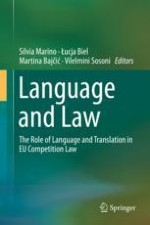2018 | OriginalPaper | Buchkapitel
Language and Translation in EU Competition Law: Insights from English, Greek, Italian and Spanish Versions of Legislative Texts
verfasst von : Vilelmini Sosoni
Erschienen in: Language and Law
Aktivieren Sie unsere intelligente Suche, um passende Fachinhalte oder Patente zu finden.
Wählen Sie Textabschnitte aus um mit Künstlicher Intelligenz passenden Patente zu finden. powered by
Markieren Sie Textabschnitte, um KI-gestützt weitere passende Inhalte zu finden. powered by
